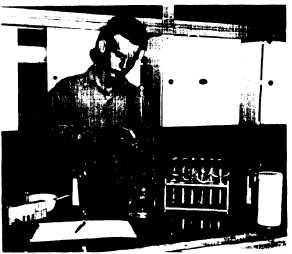from forming, or has enough alkalinity to keep the silica soluble. no great difficulty is encountered. The amount of soluble silica can be limited by continuous or routine boiler blowdown to prevent buildup of excessive concentrations.
CORROSION
Corrosion control occurs with the problem of scale control. Boilers, feedwater heaters, and associated piping must be protected against corrosion. Corrosion results from water that is acidic (contains dissolved oxygen and carbon dioxide). Corrosion is prevented by removing these dissolved gases by deaeration of feedwater, by neutralizing traces of dissolved gases in effluent of the deaerating heater by use of suitable chemicals. and by neutralizing acidity in water with an alkali.
METHODS OF TREATMENT
The specific method of chemical treatment used varies with the type of boiler and the specific properties of the water from which the boiler feed is derived. In general, however, the chemical treatment of feedwater and boiler water is divided into two broad types or methods-external treatment and internal treatment of makeup water for alkalinity control and for removal of scale-forming materials and dissolved gases (oxygen and carbon dioxide) before the water enters the boiler. "Internal treatment" means that chemicals are put directly into the boiler feedwater or the boiler water inside the boiler. Frequently, both external and internal chemical treatments are used.
External treatment. frequently followed by some internal treatment, often provides better boiler water conditions than internal treatment alone. However, external treatment requires the use of considerable equipment, such as chemical tanks, softening tanks, filters, or beds of minerals, and the installation costs are high. Such treatment is therefore used only when the makeup water is so hard or so high in dissolved minerals or when internal treatment by itself does not maintain the desired boiler water conditions. What is the dividing line between the hardness and the concentration of dissolved matter in water? What factors other than the dividing line determine the need for external treatment? These factors are the physical makeup of the plant. the type and design of the boilers used, the percentage of makeup water being used, the amount of sludge the oiler can handle, the space available, and the adaptability of the operators. Many methods of INTERNAL TREATMENT are in use. Most of these treatments use carefully controlled boiler water alkalinity, an alkaline phosphate, and organic material. One of the organic materials used is tannin. Tannin is a boiler water sludge dispersant; that is, it makes precipitates more fluid and prevents their jelling into masses that are difficult to remove by blowdown. Because of treatment costs and simplicity of chemical concentration control, the alkaline phosphate-tannin method of internal treatment is perhaps the most widely used. When properly applied and controlled, this treatment prevents formation of scale on internal boiler surfaces and prevents corrosion of the boiler tubes and shell.
BOILER WATER TESTING
As we have just seen. boiler water must be treated with chemicals to prevent the formation of scale on the internal surface of the boiler and to prevent deterioration of the boiler metal by corrosion. Boiler water must be tested to determine the sufficiency of chemical residuals to maintain clean boiler surfaces. As a Utilitiesman, you should be able to make various boiler water tests (fig. 1-28). The procedures for a few types of tests that you may have to make is given here - tests for hardness. phosphate. tannin. caustic alkalinity (with and without tannin), sodium sulfite, and pH. A test kit is provided for the different tests. Each test kit contains the equipment and materials for the specified test. If a kit is not available, you have to use the laboratory equipment (figs. 1-29 and 1-30) provided in the boiler or water treatment plants.

Figure 1-28. - Testing boiler water is an important job.
Continue Reading